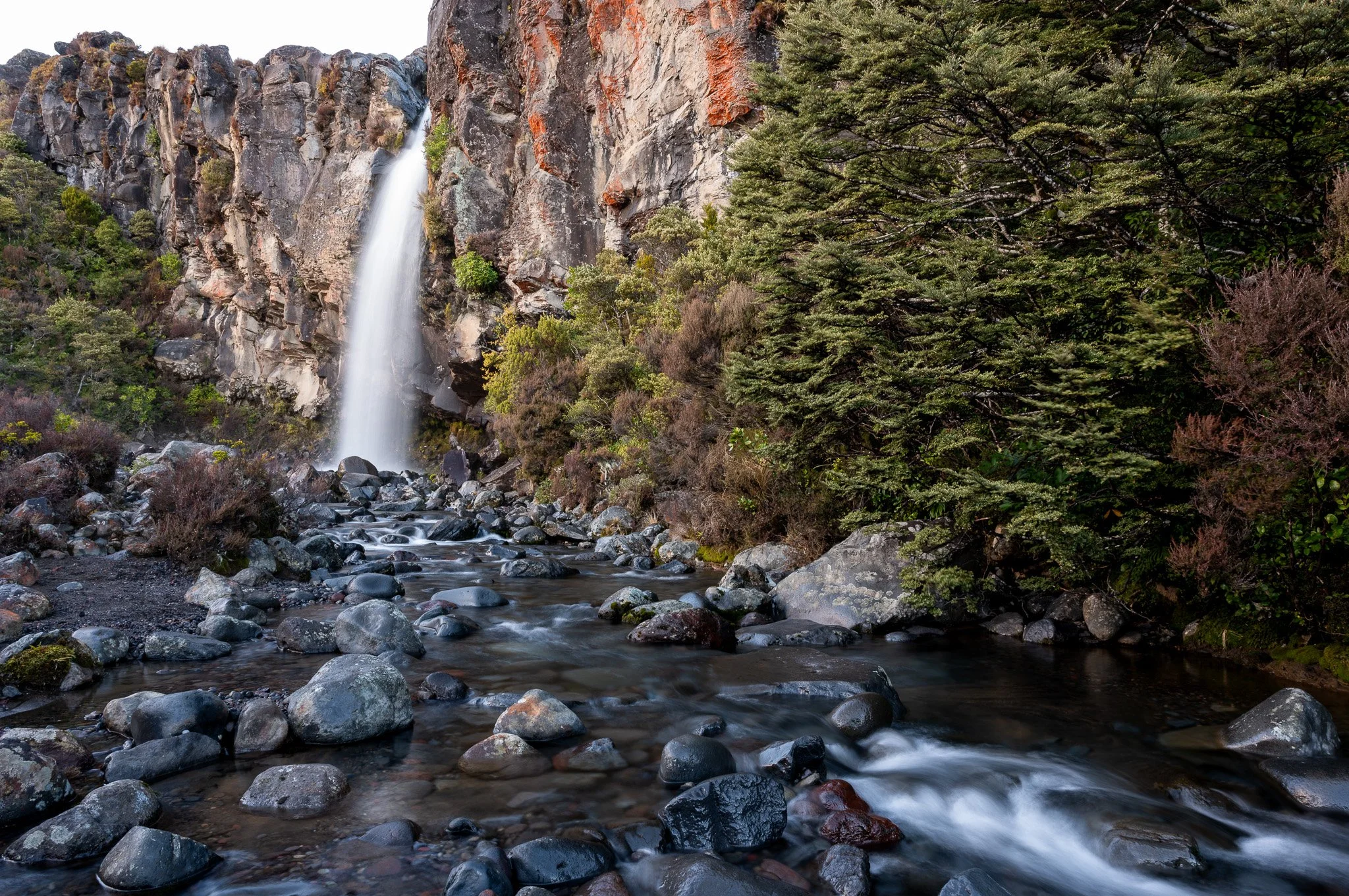Tongariro Natioanl Park
Sunrise panorama of Tongariro National Park: Mount Ruapehu in the back, Tama Lakes and Ngāuruhoe crater with its shadow.
Tongariro National Park, New Zealand’s oldest national park and a dual UNESCO World Heritage site, is a geological marvel shaped by over 275,000 years of volcanic activity. The park is centred around three active volcanoes: Mount Ruapehu, Mount Ngauruhoe, and Mount Tongariro, each with its own distinct geological history and cultural significance.
-
Mount Tongariro, the oldest of the three, began erupting around 275,000 years ago. The park’s volcanic landscape is a direct result of these millennia of geological activity, featuring active craters, vast lava flows, and geothermal areas. Notable features include Emerald Lakes and Blue Lake, formed in explosion craters and filled with acidic, mineral-rich waters that give them their distinctive colours. Red Crater, prominent on the Tongariro Alpine Crossing, showcases layers of oxidized iron, highlighting ongoing volcanic processes. Tama Lakes, nestled between Mount Ngauruhoe and Mount Ruapehu, occupy six explosion craters formed about 10,000 years ago, adding to the park’s dramatic volcanic scenery.
Mount Ngauruhoe, a secondary cone of Mount Tongariro, is a relatively young formation with initial eruptions dating back approximately 2,500 years. Its near-perfect conical shape makes it one of New Zealand’s most iconic and visually striking peaks. Ngauruhoe gained international fame as the stand-in for Mount Doom in Peter Jackson's The Lord of the Rings trilogy, where its symmetrical form provided a dramatic backdrop for the fictional story. This portrayal highlighted its resemblance to the fiery mountain described in J.R.R. Tolkien’s novels, cementing its status as a symbol of volcanic grandeur. Its most recent notable eruptions occurred between 1954 and 1975, demonstrating its ongoing geological dynamism. No wonder, that Ngauruhoe means “throwing hot stones” in Māori.
Mount Ruapehu, the highest and most massive of the park's volcanoes, has been a significant geological feature for about 200,000 years. It is renowned for its prominent Crater Lake, which sits within the summit crater. This lake is a key indicator of the mountain's geothermal activity and is often filled with striking blue or green water due to volcanic minerals and gases. The lake's temperature can vary significantly, influenced by volcanic heat beneath the surface, and it occasionally changes in colour and clarity. Its last eruption was in 2007 when two climbers were caught in the blast at a hut 600 m from the vent.
For the Māori, these mountains are sacred ancestors. Mount Tongariro is revered as the embodiment of Ngātoroirangi, a high priest and navigator of the Te Arawa canoe. According to legend, Ngātoroirangi summoned fire from his homeland of Hawaiki to save himself from freezing atop Tongariro, leading to the volcanic activity that shaped the park, including the creation of the Tama Lakes. The mountains are seen as a spiritual link between the earth and the sky, making them tapu (sacred) and of immense cultural significance. In 1887, the Ngāti Tuwharetoa iwi, led by Chief Te Heuheu Tukino IV, gifted these sacred mountains to the people of New Zealand to ensure their protection, establishing the country’s first national park.
Little did I know the profound impact National Park Backpackers—a cosy hostel with a climbing wall, nestled next to Tongariro National Park—would have on me. It became my home on the other side of the world and a place I will always hold close to my heart. In the end, I spent nearly five out of my twelve months in New Zealand there. Through both winter and autumn, I shared unforgettable experiences with amazing people, forming lifelong friendships. My entire journey in New Zealand was, in one way or another, connected to this special place. From cooking, baking, and sharing incredible meals and drinks, to climbing, exercising, playing board games, travelling, and exploring the mountains—every moment was special.
The mountains of Tongariro National Park, just steps away from National Park Village, are truly magical, as the hostel's manager, Anna, would often say. Now, I understand why she has stayed there for over 25 years. I hiked and explored these peaks repeatedly, always with wonderful people by my side, eager to share my love for the mountains and nature. Each sunrise, sunset, and moonrise was special, and seeing the awe on my friends' faces atop Ngauruhoe, Ruapehu, and other peaks fed my soul. I am forever grateful to have shared this chapter of my life with you all!
A perfect representation of the North Island - volcano (Ngauruhoe) and kiwis. From Volcanic Loop Highway.
Beautiful Taranaki Falls on the way to Tama Lakes.
Sunrise over Ngauruhoe from Oturere Hut during my winter traverse of the Northern Circuit.
Ascending to Emerald Lakes from Oturere Hut.
Frozen Emerald Lakes in winter with the Red Crated in the back.
Winter magic on Tongariro Crossing - Red Crater and Ngauruhoe at the back.
First time ascending Ngauruhoe was in winter. It was Mike's initiation using winter gear and he would go on and buy it's own equipment shortly after.
Jagged peaks of the Pinnacles Ridge on Mount Ruapehu. Whakapapa Ski Area on an active volcano is New Zealand's largest ski field.
The beginning of Tongariro Crossing in winter.
First-time winter camping in one of the most spectacular places in New Zealand - under Ngauruhoe.
Active volcanic vent above Emerald Lakes. Photographed from Red Crater.
Shadow of Mount Ruapehu cast next to Mount Taranaki over 100km away.
Lisa climbing Ngauruhoe at sunrise with Tongariro Volcanic complex behind.
Sunset over Mount Taranaki looking back from Tongariro Crossing.
Lower Tama Lake with Mount Ruapehu at sunrise.
Having summited Ngauruhoe eight times, this sunrise was the most special for me. I had never before been beneath the lenticular clouds on the mountain peak.
Full-moon traverse of Tongariro Crossing. No crowds, only peace and magic.
Sandra, using winter gear for the first time, near Tahurangi, with 2797m the tallest of the eleven peaks of Mount Ruapehu
Sunrise from Tahurangi the highest point of New Zealand's North Island.
Upper Tama Lake with Ngauruhoe at sunrise.





















